Kingdom Plantae Family Piperaceae Scientific name Piper cubeba Rank Species | Order Piperales Genus Piper Higher classification Pepper | |
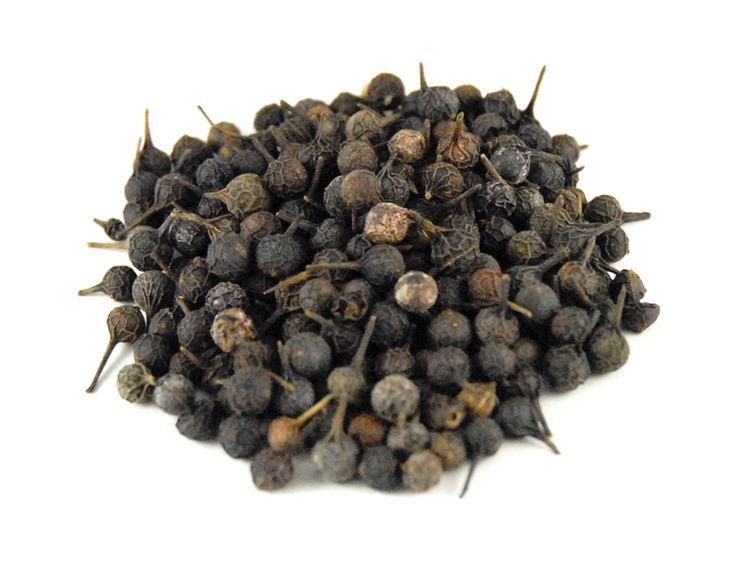 | ||
Similar Spice, Long pepper, Grains of Paradise, Pepper, Chinese cinnamon | ||
Cubeb (Piper cubeba), or tailed pepper is a plant in genus Piper, cultivated for its fruit and essential oil. It is mostly grown in Java and Sumatra, hence sometimes called Java pepper. The fruits are gathered before they are ripe, and carefully dried. Commercial cubebs consist of the dried berries, similar in appearance to black pepper, but with stalks attached – the "tails" in "tailed pepper". The dried pericarp is wrinkled, and its color ranges from grayish brown to black. The seed is hard, white and oily. The odor of cubebs is described as agreeable and aromatic and the taste as pungent, acrid, slightly bitter and persistent. It has been described as tasting like allspice, or like a cross between allspice and black pepper.
Contents

Cubeb came to Europe via India through the trade with the Arabs. The name cubeb comes from Arabic kabāba (كبابة), which is of unknown origin, by way of Old French quibibes. Cubeb is mentioned in alchemical writings by its Arabic name. In his Theatrum Botanicum, John Parkinson tells that the king of Portugal prohibited the sale of cubeb to promote black pepper (Piper nigrum) around 1640. It experienced a brief resurgence in 19th-century Europe for medicinal uses, but has practically vanished from the European market since. It continues to be used as a flavoring agent for gins and cigarettes in the West, and as a seasoning for food in Indonesia.
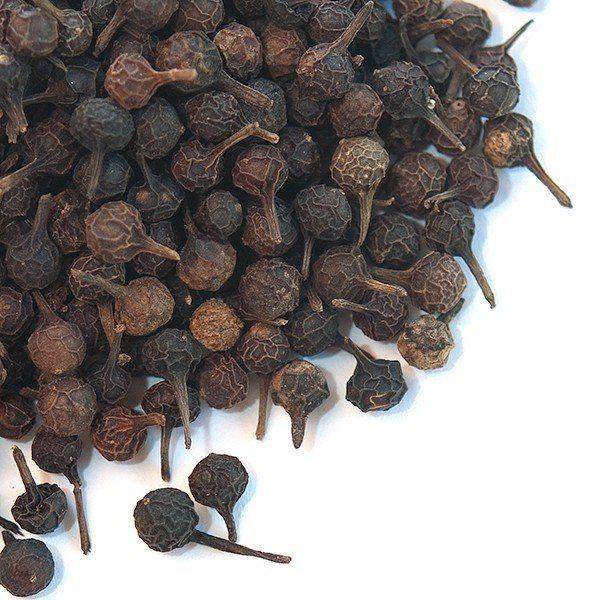
Cubeb meaning
History
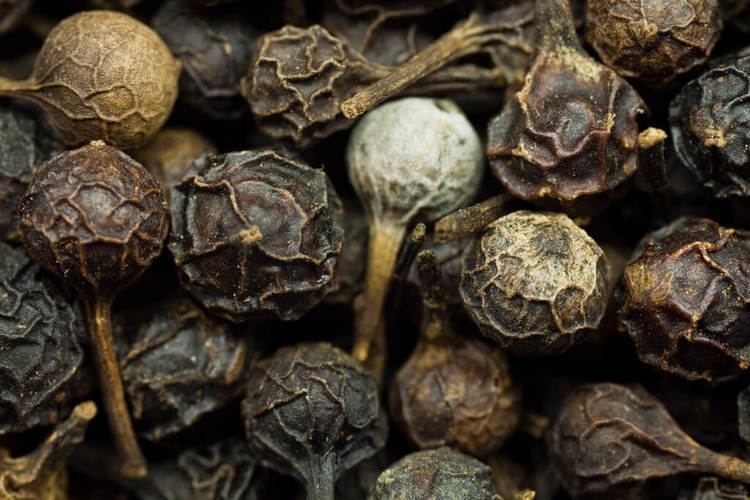
In the fourth century BC, Theophrastus mentioned komakon, including it with cinnamon and cassia as an ingredient in aromatic confections. Guillaume Budé and Claudius Salmasius have identified komakon with cubeb, probably due to the resemblance which the word bears to the Javanese name of cubeb, kumukus. This is seen as a curious evidence of Greek trade with Java in a time earlier than that of Theophrastus. It is unlikely Greeks acquired them from somewhere else, since Javanese growers protected their monopoly of the trade by sterilizing the berries by scalding, ensuring that the vines were unable to be cultivated elsewhere.
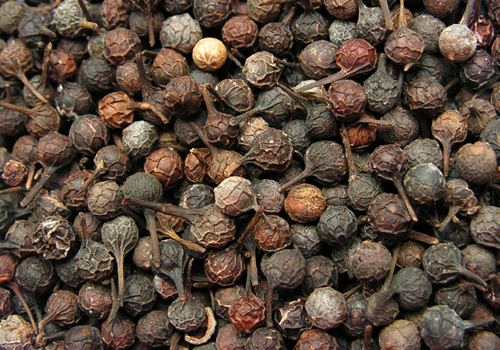
In the Tang Dynasty, cubeb was brought to China from Srivijaya. In India, the spice came to be called kabab chini, that is, "Chinese cubeb", possibly because the Chinese had a hand in its trade, but more likely because it was an important item in the trade with China. In China this pepper was called both vilenga, and vidanga, the cognate Sanskrit word. Li Hsun thought it grew on the same tree as black pepper. Tang physicians administered it to restore appetite, cure "demon vapors", darken the hair, and perfume the body. However, there is no evidence showing that cubeb was used as a condiment in China.
The Book of One Thousand and One Nights, compiled in the 9th century, mentions cubeb as a remedy for infertility, showing it was already used by Arabs for medicinal purposes. Cubeb was introduced to Arabic cuisine around the 10th century. The Travels of Marco Polo, written in late 13th century, describes Java as a producer of cubeb, along with other valuable spices. In the 14th century, cubeb was imported into Europe from the Grain Coast, under the name of pepper, by merchants of Rouen and Lippe. A 14th-century morality tale exemplifying gluttony by the Franciscan writer Francesc Eiximenis describes the eating habits of a worldly cleric who consumes a bizarre concoction of egg yolks with cinnamon and cubeb after his baths, probably as an aphrodisiac.
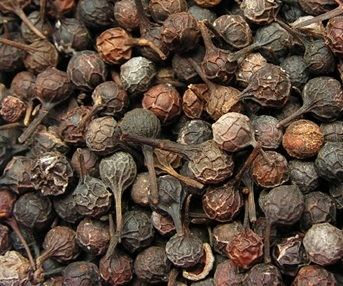
Cubeb was thought by the people of Europe to be repulsive to demons, just as it was by the people of China. Ludovico Maria Sinistrari, a Catholic priest who wrote about methods of exorcism in the late 17th century, includes cubeb as an ingredient in an incense to ward off incubus. Even today, his formula for the incense is quoted by neopagan authors, some of whom also claim that cubeb can be used in love sachets and spells.
After the prohibition of sale, culinary use of cubeb decreased dramatically in Europe, and only its medicinal application continued to the 19th century. In the early 20th century, cubeb was regularly shipped from Indonesia to Europe and the United States. The trade gradually diminished to an average of 135 t (133 long tons; 149 short tons) annually, and practically ceased after 1940.
Chemistry
The dried cubeb berries contain essential oil consisting monoterpenes (sabinene 50%, α-thujene, and carene) and sesquiterpenes (caryophyllene, copaene, α- and β-cubebene, δ-cadinene, germacrene), the oxides 1,4- and 1,8-cineole and the alcohol cubebol.
About 15% of a volatile oil is obtained by distilling cubebs with water. Cubebene, the liquid portion, has the formula C15H24. It is a pale green or blue-yellow viscous liquid with a warm woody, slightly camphoraceous odor. After rectification with water, or on keeping, this deposits rhombic crystals of camphor of cubebs.
Cubebin (C20H20O6) is a crystalline substance existing in cubebs, discovered by Eugène Soubeiran and Capitaine in 1839. It may be prepared from cubebene, or from the pulp left after the distillation of the oil. The drug, along with gum, fatty oils, and malates of magnesium and calcium, contains also about 1% of cubebic acid, and about 6% of a resin. The dose of the fruit is 30 to 60 grains, and the British Pharmacopoeia contains a tincture with a dose of 4 to 1 dram.
Medicinal
In India, the ancient texts of Ayurveda (Sanskrit आयुर्वेद) include cubeb in various remedies. Charaka and Sushruta prescribe a cubeb paste as a mouthwash, and the use of dried cubebs internally for oral and dental diseases, loss of voice, halitosis, fevers, and cough. Unani physicians use a paste of the cubeb berries externally on male and female genitals to intensify sexual pleasure during coitus. Due to this attributed property, cubeb was called "Habb-ul-Uruus".
In traditional Chinese medicine cubeb is used for its alleged warming property. In Tibetan medicine, cubeb (ka ko la in Tibetan) is one of bzang po drug, six fine herbs beneficial to specific organs in the body, with cubeb assigned to the spleen.
Arab physicians of the Middle Ages were usually versed in alchemy, and cubeb was used, under the name kababa, when preparing the water of al butm. The Book of One Thousand and One Nights mentions cubeb as a main ingredient in making an aphrodisiac remedy for infertility:
The mixture, called "seed-thickener", is given to Shams-al-Din, a wealthy merchant who had no child, with the instruction that he must eat the paste two hours before having intercourse with his wife. According to the story, the merchant did get the child he desired after following these instructions. Other Arab authors wrote that cubeb rendered the breath fragrant, cured affections of the bladder, and that eating it "enhances the delight of coitus".
In 1654, Nicholas Culpeper wrote in the London Dispensatorie that cubebs were "hot and dry in the third degree... (snip) they cleanse the head of flegm and strengthen the brain, they heat the stomach and provoke lust". A later edition in 1826 informed the reader that "the Arabs call them Quabebe, and Quabebe Chine: they grow plentifully in Java, they stir up venery. (snip) ...and are very profitable for cold griefs of the womb".
The modern use of cubeb in England as a drug dates from 1815. There were various preparations, including oleum cubebae (oil of cubeb), tinctures, fluid extracts, oleo-resin compounds, and vapors, which were used for throat complaints. A small percentage of cubeb was commonly included in lozenges designed to alleviate bronchitis, in which the antiseptic and expectoral properties of the drug are useful. The most important therapeutic application of this drug, however, was in treating gonorrhea, where its antiseptic action was of much value. William Wyatt Squire wrote in 1908 that cubebs "act specifically on the genito-urinary mucous membrane. (They are) given in all stages of gonorrhea". As compared with copaiba in this connection cubeb has the advantages of being less disagreeable to take and somewhat less likely to disturb the digestive apparatus in prolonged administration..
The volatile oil, oleum cubebae, was the form in which cubeb is most commonly used as a drug, the dose being 5 to 20 minims, which may be suspended in mucilage or given after meals in a wafer. The drug exhibited the typical actions of a volatile oil, but exerted some of these to an exceptional degree. As such, it was liable to cause a cutaneous erythema in the course of its excretion by the skin, had a marked diuretic action, and was a fairly efficient disinfectant of the urinary passages. Its administration caused the appearance in the urine of a salt of cubebic acid which was precipitated by heat or nitric acid, and was therefore liable to be mistaken for albumin, when these two most common tests for the occurrence of albuminuria were applied.
The National Botanic Pharmacopoeia printed in 1921 tells that cubeb was "an excellent remedy for flour albus or whites."
Culinary
In Europe, cubeb was one of the valuable spices during the Middle Ages. It was ground as a seasoning for meat or used in sauces. A medieval recipe includes cubeb in making sauce sarcenes, which consists of almond milk and several spices. As an aromatic confectionery, cubeb was often candied and eaten whole. Ocet Kubebowy, a vinegar infused with cubeb, cumin and garlic, was used for meat marinades in Poland during the 14th century. Cubeb can still be used to enhance the flavor of savory soups.
Cubeb reached Africa by way of the Arabs. In Moroccan cuisine, cubeb is used in savory dishes and in pastries like markouts, little diamonds of semolina with honey and dates. It also appears occasionally in the list of ingredients for the famed spice mixture Ras el hanout. In Indonesian cuisine, especially in Indonesian gulés (curries), cubeb is frequently used.
Cigarettes and spirits
Cubeb was frequently used in the form of cigarettes for asthma, chronic pharyngitis and hay fever. Edgar Rice Burroughs, being fond of smoking cubeb cigarettes, humorously stated that if he had not smoked so many cubebs, there might never have been Tarzan. "Marshall's Prepared Cubeb Cigarettes" was a popular brand, with enough sales to still be made during World War II. Occasionally, marijuana users claimed that smoking marijuana is no more harmful than smoking cubeb. In the musical The Music Man, set in rural Iowa in 1912, the character Harold Hill alarms parents by telling them that their sons are trying out cubeb cigarettes at the notorious pool hall in the song "Trouble".
In 2000 cubeb oil was included in the list of ingredients found in cigarettes, published by the Tobacco Prevention and Control Branch of North Carolina's Department of Health and Human Services.
Bombay Sapphire gin is flavored with botanicals including cubeb and grains of paradise. The brand was launched in 1987, but its maker claims that it is based on a secret recipe dating to 1761. Pertsovka, a dark brown Russian pepper vodka with a burning taste, is prepared from infusion of cubeb and capsicum peppers.
Other
Cubeb is sometimes used to adulterate the essential oil of Patchouli, which requires caution for Patchouli users. In turn, cubeb is adulterated by Piper baccatum (also known as the "climbing pepper of Java") and Piper caninum.
Cubeb berries are used in love-drawing magic spells by practitioners of hoodoo, an African-American form of folk magic.
In 2000, Shiseido, a well-known Japanese cosmetics company, patented a line of anti-aging products containing formulas made from several herbs, including cubeb.
In 2001, the Swiss company Firmenich patented cubebol, a compound found in cubeb oil, as a cooling and refreshing agent. The patent describes application of cubebol as a refreshing agent in various products, ranging from chewing gum to sorbets, drinks, toothpaste, and gelatin-based confectioneries.
